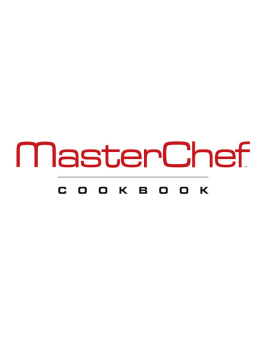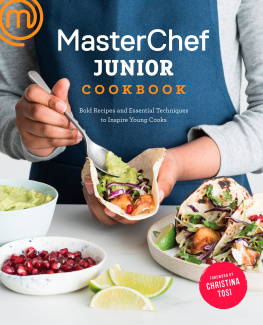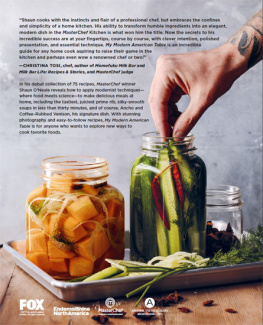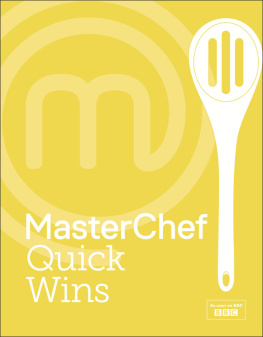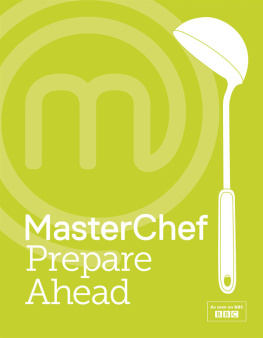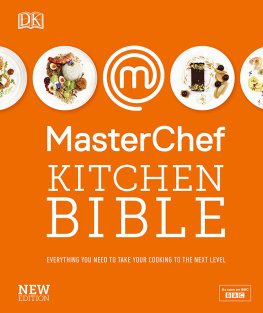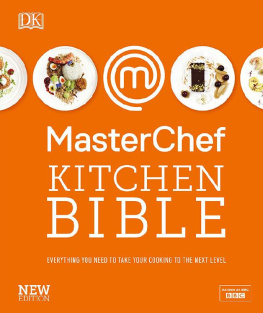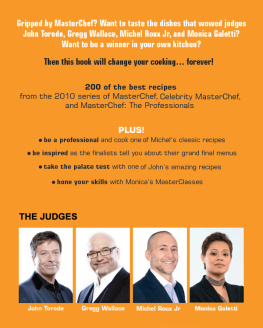Gearing Up
Building a cooks kitchen is an exciting challenge. Its normal to feel a little overwhelmed in kitchenware shops, surrounded by all of those gleaming copper pots and pans, sharp knives, and high-tech gadgets. Dont be intimidated! You just need to know the basics: the essential tools youll need to prepare even the most intricate recipe. Steer clear of cutesy, colorful gadgets and cheap knives that never need to be sharpened. Spend your money wisely to get the most out of your culinary budget.
When it comes to kitchen equipment, the expression You get what you pay for could not be truer. A few good pieces will last a lifetime (and sometimes longer). Most well-made kitchen equipment comes with a lifetime replacement warranty. In the long run, its more economical to buy a piece thats backed by a good guarantee than one youll have to replace over and over. The following guidelines will help you gather the equipment that no MasterChef should be without.
MasterChef Equipment Basics
KNIVES
These are the tools youll use most often in the kitchen, and a great chefs knife is symbolic of a serious cook. A high-quality knife is worth the investment and will last for years if you treat it properly and have it professionally sharpened once in a while. Look for knives that will last, with a high-carbon stainless steel blade that stays sharp and doesnt rust. The handles may be wooden or plastic; the important thing to look for is a blade that extends to the end of the handle, which is called full tang. Shop around and see what brand fits your hand well and feels comfortable and balanced when you hold it.
These three kitchen knives can be used to cover a multitude of kitchen tasks:
Chefs knife, 8-inch blade: Everyone needs a proper chefs knifeit is the most important tool in the kitchen. This is an all-purpose knife, used for a wide variety of cutting tasks, from slicing onions to chopping herbs to carving meat.
Paring knife: This is the second most used knife in the kitchen. With a 3- to 4-inch blade, the small knife is designed for precise tasks such as peeling and trimming.
Serrated knife: Serrated knives are good not only for cutting bread but also for slicing fragile fruits and soft vegetables, such as tomatoes. The teeth on serrated knives cant be sharpened, so once they are dull, the knife should be replaced.
Cutlery Care
A magnetic knife strip that mounts to your kitchen wall is the safest and best way to store your knives. Piling sharp knives in a drawer is dangerous and can nick the blades. Wooden knife blocks trap moisture and are difficult to clean; the moisture that gets trapped in those narrow slits can be a breeding ground for bacteria. Plus the blocks take up precious counter space! Never put knives in the dishwasher. A quick rinse with hot water and a soapy sponge is all you need to keep them clean. Be sure to dry them well.
The proper way to maintain the edge of the blade is using a whetstone. If you do not have a whetstone and are not inclined to learn how to use one, have your knives professionally sharpened at a local cutlery or hardware store. A sharp knife not only cuts better but is safer. A dull knife forces you to use more pressure to cut the food, causing your hand to slip. Depending on how much you cook, its a good idea to sharpen your knives every few months.
Use a sharpening steel to maintain the edges in between sharpenings. A steel does not sharpen knives, but it does keep the edges straight and aligned. A few even strokes on both sides of the blade right before you start chopping will keep those potato slices paper-thin.
Respect your knives: Start with good ones, keep them sharp, and they will be your friends.

CUTTING BOARDS
Cutting boards come in a variety of materialssuch as wood, plastic, marble, or glassand in different shapes, such as rectangular, square, or round. Marble and glass boards arent particularly good for your knives as their surface is too hard and dulls the blade. Plastic cutting boards are dishwasher safe and very easy to clean. Youll always need more than one cutting board. Keep a designated plastic cutting board for poultry to prevent cross-contamination. Its also a good idea to keep a small board used only for chopping garlic to avoid transferring its strong odor to other ingredients.
Wooden cutting boards are heavy, and some of the more decorative boards are quite attractive for displaying in your kitchen. These boards give a truly resistant cutting surface while being kind to the blades sharp edge. Always be scrupulous about scrubbing boards after use in hot soapy water, and dry them well. Never submerge wooden boards in a sink of water. Wood is porous and will soak up water, causing the cutting board to warp and crack when it dries.
Rub mineral oil on wooden cutting boards to prevent staining and absorption of food odors and bacteria. The oil prevents knife marks on the board and keeps the wood looking new. Never use cooking oils to treat a cutting boardin time, the wood will reek of rancid oil. An occasional sanding will return a wooden board to a smooth luster, if needed.
Sanitize both wood and plastic cutting boards with a diluted chlorine bleach or vinegar solution consisting of 1 tablespoon of bleach or white vinegar in 1 cup of water.
To keep your cutting board from sliding around on the counter, put a couple of damp paper towels underneath it.
COOKWARE
A few good-quality pots and pans in varying sizes are an excellent start when outfitting a kitchen. Fancy copper cookware is by no means a necessity to be a great cook. There are a lot of choices out there. Seek out reputable brands, and feel for weight. Here are some essential pieces that will help you cook with confidence:
Medium-size saucepans, 2-quart and 3-quart capacity: These are good for everything from making sauces to boiling an egg and cooking rice.
Large stockpot: Youll use this for cooking pasta, soups, and stews.
Dutch oven (or covered casserole), 4- or 5-quart capacity: This stove-to-oven-to-table vessel is an essential piece of cookware, perfect for braises and simmering dishes such as chili.
Skillets, 10 inches and 12 inches in diameter: Skillets are your everyday saut pansyoull use them regularly.
A well-seasoned cast-iron skillet, preferably an heirloom: These are great for baking cornbread and cooking other rich foods. Cast-iron skillets should never be scrubbedthe idea is to season a skillet. Gently clean after each use.
Nonstick omelet pan, 8 inches in diameter: This will help you create perfect eggs in the morning.
Buy other pots and pans as you need them. For instance, if you find that youre doing a lot of grilling, it might be worth it to invest in a ridged grill pan. If you cook a lot of Asian dishes, it would probably make sense to buy a wok. If you plan on hosting Thanksgiving each year at your house, invest in a durable roasting pan to make memorable turkeys.
Cookware should be ovenproof (no plastic handles!) so it can transfer from the stove top to the oven. It is both useful and practical to pan-roast a chicken breast by searing it first, then finishing it in the oven. Look for well-made, heavy pots and pans. Heavier pans distribute heat evenly and prevent hot spots so food doesnt burn.

BAKEWARE
Pick up several baking pans in different sizes. They can be used to bake desserts as well as cook savory ingredients, such as root vegetables, fish, and meat. They have a small lip around the sides, so heat circulates evenly around the food. A 9 13-inch glass or ceramic baking dish is perfect for roasting a chicken, baking brownies, and making macaroni and cheese.

